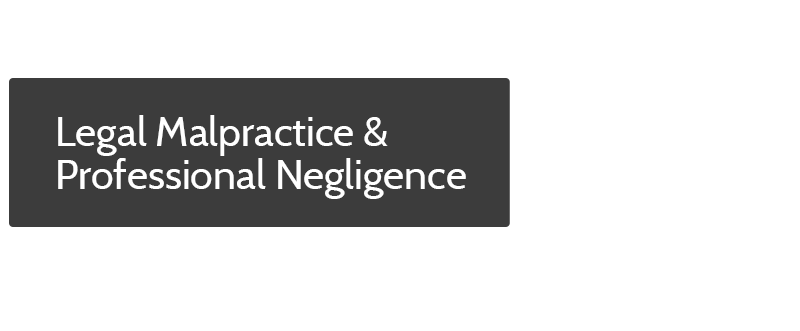Who Can Sue a Lawyer For Malpractice?
GENERALLY, AN ATTORNEY-CLIENT RELATIONSHIP IS A PREREQUISITE FOR MALPRACTICE CLAIMS.
Most legal malpractice claims fall under the heading of “professional negligence” and, like other forms of negligence claims, require the existence (and breach) of some duty between the parties.
In most cases, the duty required to support a malpractice action springs from the existence of an attorney-client relationship. In fact, the general rule is that lawyers have no professional duty to non-clients, and will not be held liable for malpractice where the plaintiff is/was not a client.
CALIFORNIA RECOGNIZES A FEW SITUATIONS WHERE NON-CLIENTS CAN SUE A LAWYER FOR MALPRACTICE.
Although the general rule in California limits legal malpractice claims to clients, the law also recognizes some (limited) exceptions, normally in situations where the attorney could have foreseen the harm his or her professional negligence would cause to a non-client plaintiff (and where holding the lawyer responsible outweighs the burden of imposing a duty to a non-client) or where the non-client plaintiff was an intended beneficiary of the lawyer’s professional services.
Courts evaluating whether or not to impose malpractice liability on a defendant lawyer when the plaintiff is a non-client will generally consider the following factors:
1. The foreseeability of harm to the plaintiff from the defendant’s acts or omissions.
2. Whether, and to what extent, the lawyer’s actions or transactions upon which the claim rests were intended to impact the plaintiff.
3. The connection between the lawyer’s actions and the plaintiff’s injury.
4. The moral culpability of the lawyer’s conduct.
5. The degree of certainty that the plaintiff suffered injury (as a result of the defendant’s conduct).
6. The public policy impact — specifically, the strength of the public policy involved in preventing future similar harm.
7. The burden that liability would place on the defendant and similarly situated lawyers. (Not just in terms of the case at issue, but in preventing malpractice in similar future situations.)
8. Whether holding the defendant lawyer liable will or might interfere (or have interfered) with the lawyer’s duty to his or her clients.
Evaluation of whether or not a non-client plaintiff has standing to bring a malpractice claim against an attorney is complicated and technical. Never attempt to evaluate your legal rights yourself. If you believe you have been injured by a lawyer’s action or inaction (whether or not you were the lawyer’s client), consult an experienced attorney immediately for an evaluation of your legal rights and potential claims.
***
Disclaimer: THIS ARTICLE IS FOR INFORMATIONAL PURPOSES ONLY, AND DOES NOT CONSTITUTE LEGAL ADVICE OR CREATE AN ATTORNEY-CLIENT RELATIONSHIP BETWEEN THE AUTHOR AND ANY PERSON. Your rights and experiences may vary. Never use an online article (including this one) to evaluate your legal claims. Speak with an experienced lawyer promptly to obtain a personalized evaluation of your claims, possible damages, and options. You may lose or compromise your rights if you delay in consulting legal counsel. Malpractice (professional negligence) claims are complicated and fact-dependent. If you believe you have a claim against an attorney who represented you, or any other type of legal claim, consult an experienced lawyer immediately for an evaluation of your personal rights and claims.














